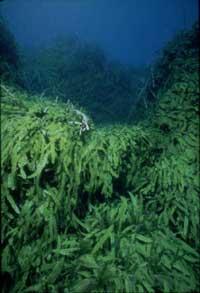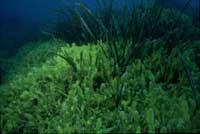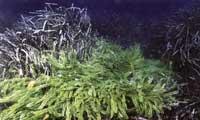Caulerpa taxifolia. The murderer of the Mediterranean
The Caulerpa taxifolia began the Mediterranean history of the beautiful green algae in a recycle bin. Specifically in a bin of the oceanographic museum of Monaco. Dr. Denis Ody, PhD in oceanography, began in 1992 to investigate the details of C. taxifolia and, although he did not expect it, received terrible statements. In fact, a head of the rear of the Monaco Museum told him that when cleaning the containers they were not too busy. The algae were extracted from the root and thrown directly from the window into the sea. Due to the weight of the bins, no attempt was made to take them to landfills. In his opinion, no one thought that a tropical seaweed could survive in the Mediterranean!

Now we know. C. taxifolia is able to survive in the Mediterranean and not only that, also to invade the Mediterranean! Since 1960 the algae used in Europe for aquarium decoration began to be investigated in 1992, but it began to expand earlier. Its dissemination has been thoroughly monitored. In 1992, between March and October, the area occupied by C. taxifolia went from 50 hectares to 180 hectares. In 1994 the area gained by the algae amounted to 600 hectares, in 1995 to 730 hectares and in 1998 to 1,500 hectares. Today it has invaded 6,000 hectares on the Mediterranean coast (Spain, France, Monaco, Italy, Croatia).
The worst thing is that the place of residence of this algae is not limited to the Mediterranean. And it has recently been discovered on the coast of California. Olivier Jousson, researcher at the University of Geneva, has compared the varieties C. taxifolia, from the Mediterranean, Red Sea, Indian, Pacific, Caribbean and Aquariums. He has concluded that the seaweed found on the coast of California is a Mediterranean variety, and it has become clear that the seaweed found in the Red Sea and in the tropics is totally different. Finally, the research clearly shows the hypothesis that museum officials have wanted to deny in recent years. That is, it has been introduced in the Mediterranean by aquatic algae.
In view of this expansion, scientists from the peoples of the Mediterranean have joined in stating that C. taxifolia is a danger to destroy biological balance.
Conditions for your next broadcast
C. taxifolia has a peculiar and simple anatomy. It is the only cell with many cores. It is not easy to disappear, as the plant dies from one end and the other grows. Some mutations have turned the small tropical plant into an invasive 80 centimeters in the Mediterranean. It is enough, for example, for marine currents or a boat to unconsciously root a cuttings from one side to the other to root taxifolia C in this new area. A cutting can colonize an area of ten meters with high density (14,000 pages per square meter) and form a stem of one hundred meters. No wonder it spreads at such high speed!

In addition, it is undemanding with the environment and adapts to all types of substrates. No matter whether it is rock, sand or wild, even if you prefer solid substrates. Moreover, it can also be fixed in clean or contaminated places like ports. Luminosity and temperature changes are also not an obstacle to its expansion. Unlike the Australian variety, the Mediterranean supports cold temperatures well. Temperature changes have a lot to do with the development of these algae, but that is not why it dies. You can spend 3 months in water at 10 degrees. At the end of summer and autumn it increases by two centimeters per day.
C. taxifolia is a seaweed that also adapts to different light intensities. 50 meters deep covers the surface of the substrate by 50% and 100%. At greater depths the population density decreases considerably, although C. taxifolia can live up to -100 meters. At the moment, it is estimated that the depth limit is 182 meters. Finally, it meets the last indispensable condition for its easy expansion, has no predators and emits a toxic substance to chase away fish.
The diversity of fauna and flora of the Mediterranean Sea has decreased considerably. The 'carpet' generated by C. taxifolia, with the simple covering, destroys all sustainable vegetation. Being toxic, the fauna directly related to this vegetation is having direct consequences, since the animals cannot replace their usual food with this new algae. Some species are disappearing and others multiply. Fishermen have also begun to suffer the consequences of algae, as algae fragments that emerge in the marine currents destroy the nets of fishermen
In elimination efforts
The breadth it has reached makes it unclear how to control and eliminate. In 1992, for example, in the Balearic Islands and in the Natural Park of Port-Cros, it was attempted to start the first stalks. Somewhere not all cuttings would be removed, since today in these areas you can still find C. taxifolia. In California 3,500 m 2 of chlorine algae have been removed. It is not the most appropriate solution since chlorine kills all other species. On the other hand, fishermen have been asked, if they find them in the nets, to store them in a trash can and deposit them on the ground.

The last solution being studied is to promote biological struggle. In this sense, since 1994 the INRA (Institut National pour la Recherche Agronomique) in France has been working. It is intended to use some mollusks that do not eat C.taxifolia but absorb the cytoplasm of the cell. Toxic products of algae do not influence these calming ones and, moreover, tranquil ones keep them for use against carnivores. Algae have developed another type of defense. Thanks to the coagulation of special proteins, they create a kind of barrier that forces the serene to make a bigger hole. At the moment, the spleen that inhabits the Mediterranean is little extended to limit the invasion of the C. taxophilia and is considering bringing from the tropics other species.
It is not the first human species to penetrate the seaThe number of species that are introduced into the seas and oceans, voluntarily or involuntarily, in the last twenty years has increased considerably, mainly due to the cruises of the ships. For example, a boat that traveled through the West Atlantic, around 1982, took the invertebrate Mnemiopsis leidyi to the Black Sea. Although they initially seem harmless, small species can cause a huge disaster. An animal similar to a translucent Medusa, which at the age of ten completely destroyed the fishing of the Black Sea. In 1984 they went from fishing 204,000 tons of anchovy, 24,600 tons of Roma sardines and 4,000 tons of verdel, not to fish 200 tons, 12,000 tons and no verdel, respectively. Other species that have spread without measure are the starfish Asterias amurensis and the crab Carcinus maenas. Both have entered the coasts of Tasmania and Australia. The star of the sea was first seen in 1986 and today there are millions of individuals. The crab, for its part, entered in 1900 and is causing a terrible disaster in molluscs, especially in oysters and mussel nurseries. In order to avoid the reproduction of these two species, the introduction of dams is being proposed. |
For more information click here
Published in the supplement Natura de Gara
Buletina
Bidali zure helbide elektronikoa eta jaso asteroko buletina zure sarrera-ontzian











